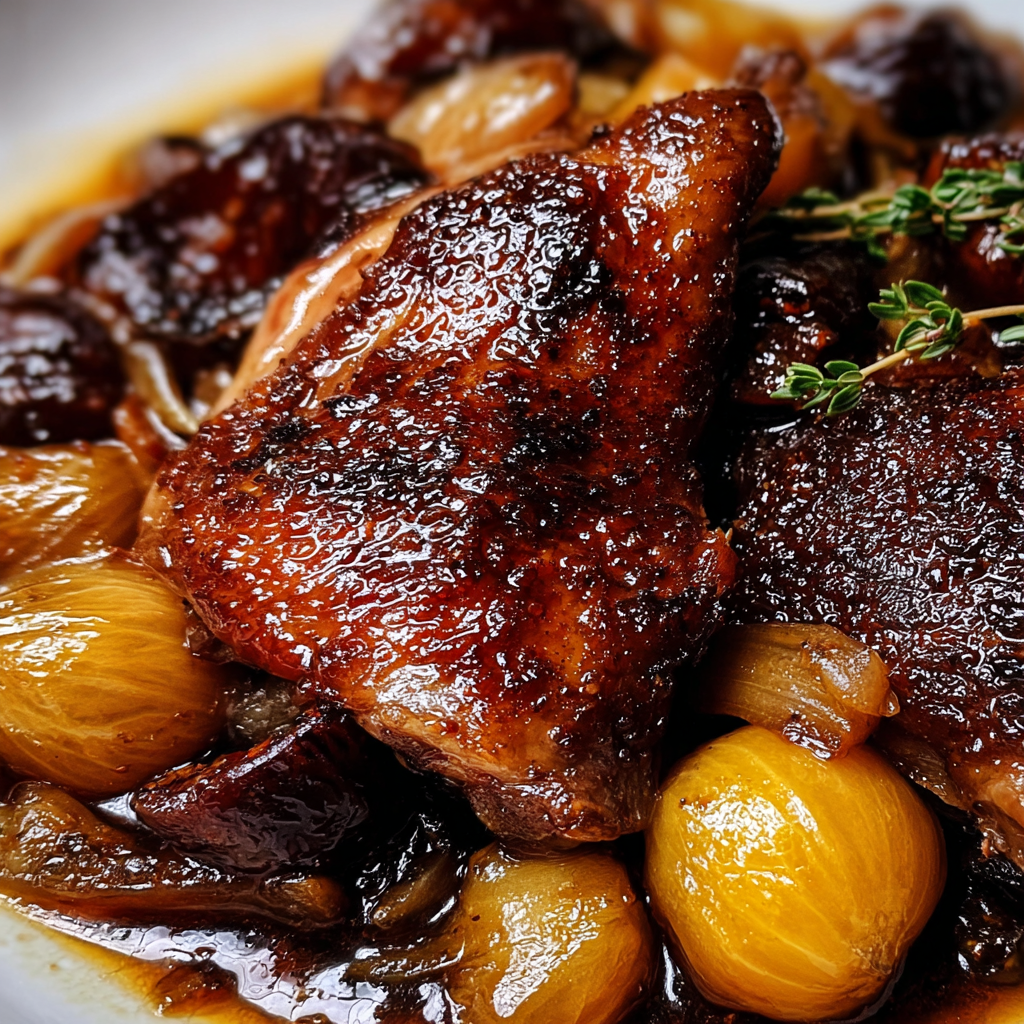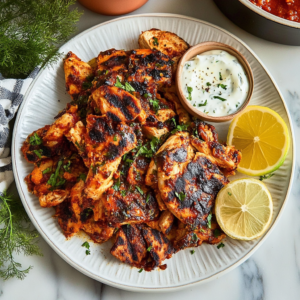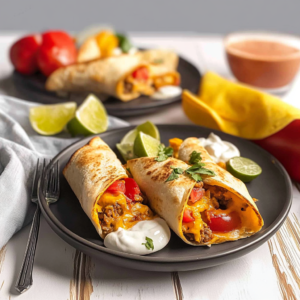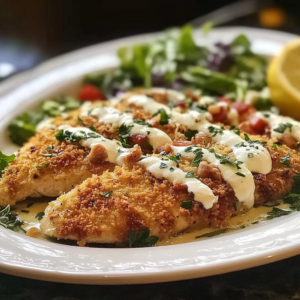Jump to:
Fig and Orange Glazed Duck – Fig Orange Glazed Duck
Fig Orange Glazed Duck combines the richness of perfectly roasted duck with a sweet-tangy glaze that transforms an ordinary dinner into an extraordinary culinary experience. This elegant recipe features tender duck meat complemented by a glossy fig and orange glaze that caramelizes beautifully during cooking. The combination of fresh herbs, aromatic spices, and the distinctive sweetness of figs creates a restaurant-quality dish you can master at home.
Why You'll Love This Recipe
- The fig and orange glaze creates a perfect balance of sweet and tangy flavors that complement the rich duck meat beautifully
- This recipe delivers restaurant-quality results at home with straightforward techniques that any home cook can master
- The impressive presentation makes it perfect for special occasions, holidays, or when you want to wow your dinner guests
- The glaze ingredients are readily available and the recipe uses simple pantry staples alongside fresh herbs for maximum flavor
- The cooking method ensures crispy skin while keeping the meat incredibly tender and juicy throughout
Why This Fig Orange Glazed Duck Recipe Works
This recipe succeeds because it combines proven cooking techniques with flavor-forward ingredients. The optional brining process ensures the duck stays moist during roasting, while the herb butter paste infuses the meat with aromatic flavors from the inside out.
The two-temperature cooking method prevents overcooking. Starting at 400°F creates initial browning, then reducing to 350°F allows gentle, even cooking. Covering the breasts partway through prevents them from drying out while the darker meat reaches proper doneness.
The fig and orange glaze brings restaurant-quality sophistication to your kitchen. The cornstarch thickening creates a glossy coating that clings beautifully to the duck skin, while the maple syrup adds depth beyond simple sweetness.
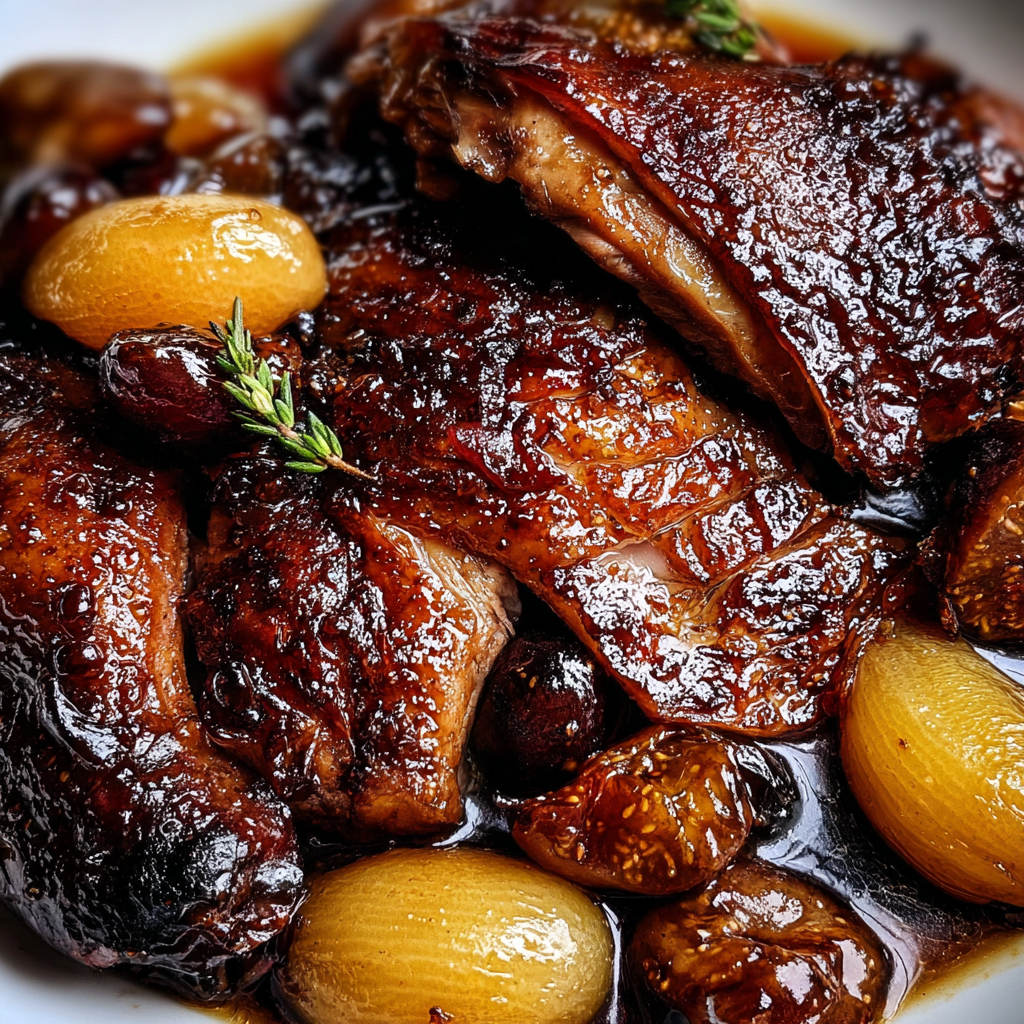
What You’ll Need for Fig Orange Glazed Duck
Ingredients
- 1 whole chilled duck
- ½ teaspoon sea salt (omit if duck is brined)
- ½ teaspoon garlic powder
- ½ teaspoon dried oregano
- ½ teaspoon dried thyme
- ½ teaspoon cracked black pepper
- 1 sprig fresh rosemary
- 2 sprigs fresh thyme
- ½ cup orange juice
- 2 tablespoons fig jam
- 2 tablespoons maple syrup
- 1 tablespoon soy sauce or coconut amino acids
- 1 teaspoon balsamic vinegar
- 1 tablespoon corn starch
Tools
You’ll need a large roasting pan or baking sheet, aluminum foil, parchment paper, a meat thermometer, and a medium saucepan for the glaze. A large pot is helpful if you choose the optional blanching step.
Having a whisk, mixing bowls, and measuring cups ready streamlines the process. Sharp kitchen shears help with any trimming, and a basting brush applies the glaze evenly for the best presentation.
How to Make Fig Orange Glazed Duck
| Step 1 – Brining (Optional): | Liberally sprinkle duck flesh with kosher salt. Cover loosely with parchment paper and refrigerate for 24 hours. |
| Step 2 – Blanching (Optional): | Boil duck in large pot for 10-30 minutes depending on age. Rest uncovered in refrigerator for 24 hours. |
| Step 3 – Preparation: | Gather all ingredients and equipment. Measure glaze ingredients. Duck can stay refrigerated until seasoning. |
| Step 4 – Butter Paste: | Mix softened butter, salt (skip if brined), spices, and herbs into a smooth paste. |
| Step 5 – Setup: | Place duck on large aluminum foil sheet. Optional: layer parchment paper under foil first. |
| Step 6 – Seasoning: | Spread butter paste inside and outside duck. Add fresh thyme and rosemary sprigs. |
| Step 7 – Initial Rest: | Cover completely with foil and rest for one hour. Preheat oven to 400°F. |
| Step 8 – First Roasting: | Uncover duck, place on roasting pan. Reduce heat to 350°F and bake uncovered for 30 minutes. |
| Step 9 – Continued Cooking: | Cover duck breasts only with foil. Continue roasting until breasts reach 135°F and thighs reach 165°F. |
| Step 10 – Glaze Preparation: | Mix all glaze ingredients except cornstarch in saucepan. Boil while whisking, then reduce heat. Dissolve cornstarch in water, add to pan, simmer until thickened. |
| Step 11 – Final Crisping: | Uncover duck completely for last 5 minutes. Remove herb sprigs and broil skin until crispy. |
| Step 12 – Resting and Glazing: | Cover duck with foil (not touching skin) and rest 15-30 minutes. Brush with glaze before serving. |
Chef's Helpful Tips
- Use a meat thermometer to ensure perfect doneness – breasts at 135°F stay juicy while thighs at 165°F become tender
- Score the duck skin in a crosshatch pattern before seasoning to help render fat and achieve crispier results
- Make the glaze while the duck rests to save time and ensure it’s the perfect consistency for brushing
- Save the rendered duck fat from the roasting pan – it’s excellent for roasting potatoes or other vegetables
- Let the duck rest properly after cooking to allow juices to redistribute throughout the meat for maximum tenderness
Serving and Storage Tips for Fig Orange Glazed Duck
Serving Tips
Serve your Fig Orange Glazed Duck immediately after glazing for the best texture contrast between crispy skin and tender meat. Carve at the table for an impressive presentation, or pre-slice in the kitchen for easier serving.
Pair this elegant dish with roasted root vegetables, wild rice pilaf, or creamy mashed potatoes. The rich flavors complement hearty side dishes beautifully. A simple green salad with citrus vinaigrette balances the richness perfectly.
Store leftovers in the refrigerator for up to three days. Reheat gently in a low oven to preserve the meat’s texture. The glaze may need refreshing – simply brush with additional warmed fig jam mixed with orange juice.
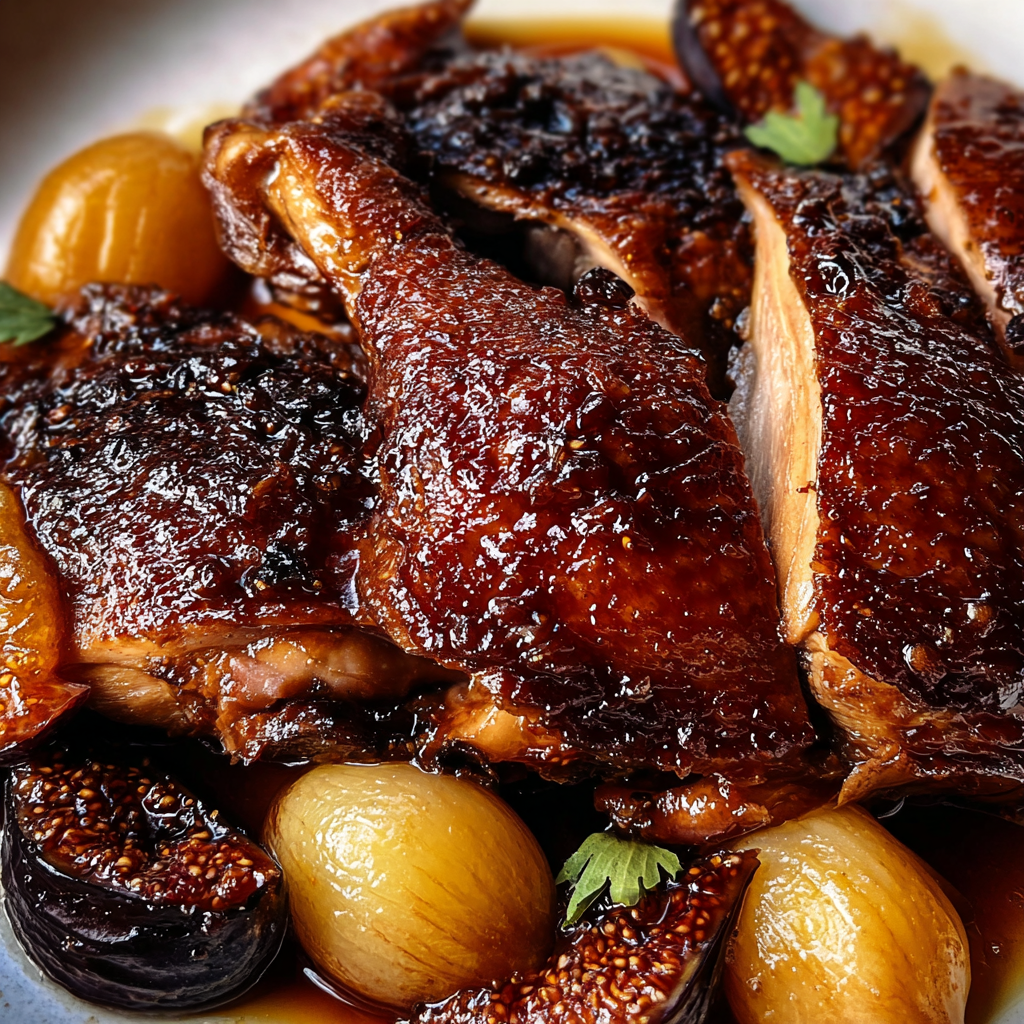
Mistakes to Avoid while making Fig Orange Glazed Duck
Don’t skip the resting period after cooking. This crucial step allows juices to redistribute, preventing dry meat when carving. Cutting too soon results in juices running out onto the cutting board instead of staying in the meat.
Avoid overcooking the breast meat. Duck breast is best served medium-rare to medium, around 135°F internal temperature. Higher temperatures create tough, dry meat that no amount of glaze can rescue.
Never apply the glaze too early in cooking. The sugars in the fig jam and maple syrup will burn under prolonged high heat. Apply the glaze only during the final minutes or after cooking for the best results.
You Must Know
- Duck renders significant fat during cooking – use a roasting rack or frequently drain the pan to prevent smoking and ensure crispy skin
- The optional brining and blanching steps dramatically improve texture and flavor, making them worth the extra time investment
- Internal temperature is crucial – use a reliable meat thermometer and check both breast and thigh temperatures for food safety
- Fresh herbs make a noticeable difference in this recipe – dried herbs can substitute but won’t provide the same aromatic impact
Suggestions for Fig Orange Glazed Duck
Transform this recipe by experimenting with different fruit preserves. Apricot jam creates a more delicate sweetness, while cherry preserves add tartness that complements the rich duck beautifully.
Consider adding fresh ginger to the glaze for warmth and complexity. A tablespoon of grated fresh ginger elevates the flavor profile significantly. For heat lovers, a pinch of red pepper flakes in the glaze creates an interesting contrast.
This cooking method works excellently for duck legs or breasts if you prefer individual portions. Adjust cooking times accordingly – duck legs need longer cooking while breasts cook faster than whole duck.
Wine enthusiasts might enjoy exploring fig and duck pairings or try a classic duck à l’orange variation. For more inspiration, check out this clementine-fig relish recipe.
Complement your meal with other special dishes like elegant desserts or sophisticated appetizers for a complete fine dining experience at home.

FAQs:
Total cooking time varies by duck size, typically 1.5-2 hours at 350°F after the initial high-heat browning. Use a meat thermometer rather than time alone – breasts should reach 135°F and thighs 165°F for optimal results.
Yes, prepare the glaze up to 2 days in advance and store refrigerated. Reheat gently before using, adding a splash of orange juice if it becomes too thick. This actually improves flavor as ingredients meld together.
Score the skin in a crosshatch pattern before cooking, start with high heat, and finish with broiling. Avoid applying sugary glaze until the final minutes to prevent burning. Proper fat rendering is key to crispy results.
Absolutely! Apricot preserves, orange marmalade, or even cherry jam work beautifully. Each creates a different flavor profile while maintaining the recipe’s sweet-tangy balance. Use the same quantity as specified for fig jam.
Use a meat thermometer inserted into the thickest part of the breast (135°F) and thigh (165°F). The juices should run clear, and the skin should be golden brown and crispy. Resting time is crucial for perfect texture.
Conclusion
Fig Orange Glazed Duck represents the perfect marriage of technique and flavor, creating a dish that’s both impressive and achievable. The combination of proper cooking methods, quality ingredients, and that stunning glaze transforms a simple duck into restaurant-quality cuisine.
This recipe rewards patience and attention to detail with incredibly satisfying results. From the optional brining that ensures moisture to the careful temperature control that guarantees perfect doneness, each step contributes to the final masterpiece.
Whether you’re planning a special celebration or simply want to elevate your cooking skills, this Fig Orange Glazed Duck delivers an unforgettable dining experience that will have everyone asking for the recipe.
More Easy Dinner Recipes:
- Juneteenth Baked Mac Cheese – Best Soul Food Recipe
- Perfect Chili Lime Corn Salad Recipe – Fresh Summer Side
- Irresistible Classic Apple Pie Recipe with Buttery Homemade Apple Pie Crust
- Cowboy Pasta Salad Recipe – Easy & Delicious Crowd-Pleaser
Recommended
📖 Recipe Card
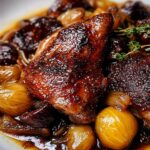
Fig Orange Glazed Duck Recipe
- Total Time: 2 hours 30 minutes
- Yield: 4-6 servings 1x
Description
Elegant roasted duck with a sweet-tangy fig and orange glaze that creates restaurant-quality results at home. Perfect for special occasions with crispy skin and tender, juicy meat.
Ingredients
- 1 whole chilled duck
- ½ teaspoon sea salt (omit if duck is brined)
- ½ teaspoon garlic powder
- ½ teaspoon dried oregano
- ½ teaspoon dried thyme
- ½ teaspoon cracked black pepper
- 1 sprig fresh rosemary
- 2 sprigs fresh thyme
- ½ cup orange juice
- 2 tablespoons fig jam
- 2 tablespoons maple syrup
- 1 tablespoon soy sauce or coconut amino acids
- 1 teaspoon balsamic vinegar
- 1 tablespoon corn starch
Instructions
- Liberally sprinkle duck flesh with kosher salt. Cover loosely with parchment paper and refrigerate for 24 hours (optional brining).
- Boil duck in large pot for 10-30 minutes depending on age. Rest uncovered in refrigerator for 24 hours (optional blanching).
- Gather all ingredients and equipment. Measure glaze ingredients. Duck can stay refrigerated until seasoning.
- Mix softened butter, salt (skip if brined), spices, and herbs into a smooth paste.
- Place duck on large aluminum foil sheet. Optional: layer parchment paper under foil first.
- Spread butter paste inside and outside duck. Add fresh thyme and rosemary sprigs.
- Cover completely with foil and rest for one hour. Preheat oven to 400°F.
- Uncover duck, place on roasting pan. Reduce heat to 350°F and bake uncovered for 30 minutes.
- Cover duck breasts only with foil. Continue roasting until breasts reach 135°F and thighs reach 165°F.
- Mix all glaze ingredients except cornstarch in saucepan. Boil while whisking, then reduce heat. Dissolve cornstarch in water, add to pan, simmer until thickened.
- Uncover duck completely for last 5 minutes. Remove herb sprigs and broil skin until crispy.
- Cover duck with foil (not touching skin) and rest 15-30 minutes. Brush with glaze before serving.
Notes
- Use a meat thermometer to ensure perfect doneness – breasts at 135°F stay juicy while thighs at 165°F become tender
- Score the duck skin in a crosshatch pattern before seasoning to help render fat and achieve crispier results
- Make the glaze while the duck rests to save time and ensure it’s the perfect consistency for brushing
- Save the rendered duck fat from the roasting pan – it’s excellent for roasting potatoes or other vegetables
- Let the duck rest properly after cooking to allow juices to redistribute throughout the meat for maximum tenderness
- Prep Time: 30 minutes
- Cook Time: 2 hours
- Category: Main Course
- Method: Roasting
- Cuisine: American
Nutrition
- Serving Size: 1 serving (6 servings total)
- Calories: 480 kcal
- Sugar: 10 g
- Sodium: 420 mg
- Fat: 30 g
- Saturated Fat: 9 g
- Unsaturated Fat: 18 g
- Trans Fat: 0g
- Carbohydrates: 13 g
- Fiber: 1 g
- Protein: 32 g
- Cholesterol: 140 mg
Keywords: glazed duck recipe, roasted duck with fruit glaze, holiday duck dinner, orange duck recipe, fig glazed poultry, elegant duck dish, special occasion duck, gourmet duck recipe
